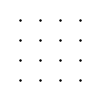

Marko Evanovich Panfilov, February 2003
In this introductory class, two methods for designing Celtic Knotwork will be described. Of course, knotwork designs are not unique to Celtic art. Many cultures and periods have used such designs. For a more in-depth discussion, see the references at the end of this article.
The two methods to be discussed are: "Interlacing Without Erasing", a method described in many SCA documents, and "Centerline Knotwork", described by George Bain. Both methods are actually very similar, but for whatever reasons, some people find one method easier to use than another. Each method also has its own advantages and disadvantages, which will be discussed below. By looking at construction lines and dots that show through pages, research has found that both of these methods were used in period.
As suggested by the title, this method of knotwork constructions doesn't require any erasing when complete. The dots used to guide the pattern are located in the background area of the knotwork which will typically be painted or carved. This is a very "free-form" design method and is useful for covering oddly shaped regions. This method is described in the Knowne World Handbook, discussed at length in the Compleat Anachronist ##118 (Winter 2003), and is also used in classes and books by Mark van Stone.
 |
Start by drawing a regular rectangular grid of dots, filling the space in which you wish to put knotwork. Dots should be equally spaced. The distance between dots is roughly the width of the knotwork ribbons you will be creating. |
 |
Once the rectangular grid is complete, add an additional dot to the center of each square. This will form the diagonal dot grid needed for knotwork. |
 |
Unless you just want a regular weave pattern throughout the entire shape, you can add breaks to cause the knotwork to loop back on itself. A break is simply a line that the knotwork is not allowed to cross. For example, the entire edge border of the design is a break. A break is either a horizontal or vertical line connecting one or more dots. Breaks can intersect at a dot, but should not cross each other anywhere else along the line. |
Breaks are useful for leaving holes in your knotwork. For example, when carving, you might want the knotwork to flow around a defect in the wood. Simply surround the defect with breaks. A symmetric or uniform pattern of line breaks will result in a symmetric and more pleasing knotwork design.
 |
Starting in an open area of your dot grid (not next to a break), draw two diagonal lines between the dots are shown in the figure. This is the start of your ribbon. Draw another set of diagonal lines going the opposite direction adjacent to the first set, as shown in the picture. Continue expanding out drawing the diagonal strips in opposite directions. This forms the under-and-over weave pattern typical of regular knotwork designs. |
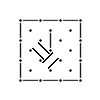   |
|
 |
Your ribbon is not allow to cross a break. But your ribbon is diagonal and breaks are horizontal or vertical. So, when you approach a break, simply curve the ribbon to avoid the break, as shown in the picture. |
 |
This method of construction allows you to draw as you go. You do not have to do any initial layout, other than the grid of dots. This free flowing method is easy to learn. Impress your friends by "doodling" knotwork using this method. The drawback of this method is that you have less control over the overall design. If you are trying to achieve a specific effect, such as only having a single ribbon intertwined with itself, it is better to use the next method. |
In a classic work by George Bain called "Celtic Art, the methods of construction," a slightly different design method is documented that I called the "Centerline" method. This is the method most easily identified in the Book of Kells. Many people find this method more complex because it requires more drawing and erasing of lines. However, I hope to show that this method is really no different than the previous method, except that you are doing more "up front" design work to determine the exact course of your ribbon.
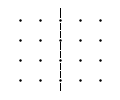 |
The first step is very similar to the previous method. Draw a rectangular grid of dots. However, it's very important that you have an odd number of dots in at least one direction. You can easily ensure you have an odd number of dots in a direction by dividing the direction in half. In the above example, the dotted line shows how the area is divided in half. |
 |
Now, go ahead and add a center dot to each square, but also add a center dot just outside of the border along the longest edge (the top and bottom edges in this example). |
 |
As with the previous method, you use breaks to control where the ribbon is not allowed to cross. Breaks are still horizontal and vertical lines, but instead of connecting dots together, a break is centered on a dot, as shown in the picture. You can still join breaks if you want. In this case, however, breaks can intersect between dots, but not on the dot itself. |
 |
The centerline of your ribbon is formed by connecting the dots diagonally. Keep following the centerline until you come to a break, then curve the centerline to avoid the break and connect to the nearest dot going the opposite diagonal direction (see picture). Continue drawing the centerline until you reach your starting point. This will be the center of one of your ribbons. If you have crossed each dot twice in your grid (once in each diagonal direction), then you have a single-ribbon pattern. If there are dots that you missed, you can either start at one of those dots and draw a second centerline, or you can modify your breaks to redirect your current centerline in a new direction. |
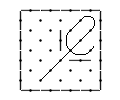 |
Using this method, most of your time is spent getting your centerline to go where you want and to form the pattern you want. Because you have only drawn a single line, it's easier to modify the path of your ribbon by changing breaks than it is with the previous method. |
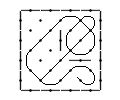  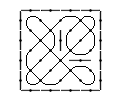 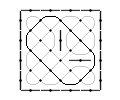 |
|
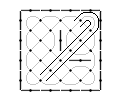 |
Think of your completed centerline as the center line of a roadway. Your next job is to draw the edges of the road around the centerline. When completed, your ribbon will consist of three lines: the two outer edges, and the center. |
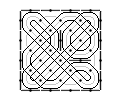 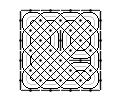 |
|
 |
Pick an intersection somewhere in your design, and decide if this is an "over" point, or an "under" point. To continue the road analogy, think of this as two roads crossing. One of the roads needs a bridge to go over the other road. Once you design which road is on top of the other road, ink the outer lines and the bridge. Following the road and whenever you get to an intersection, reverse the bridge. So, if you started on top of a road, when you get to the next intersection, go under the road. Continue this over and under approach until you have defined the direction of the bridge at each intersection. Try to think about drawing a road as viewed from above, showing how they cross over and under each other. |
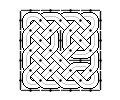 |
 |
The final step is to erase the remaining construction lines, such as the centerline and the dots. As you can see, the second method has several more steps which makes it more time consuming. The advantage of the second method is that you have greater control over your overall design. And by drawing the ribbon centerline as a complete figure, you end up with a smoother and cleaner ribbon compared to the piece-work construction of the first method. |
 |
Try both methods yourself to see which you find easier. I tend to use the first method when carving knotwork in wood because it's easier to flow around defects and there is no cleanup required. I've used the second method for all of the Celtic scrolls I have done because it gives me more control over the design and a cleaner final look. |
Bain, George, "Celtic Art, the methods of construction," Dover Publications, New York, 1973. Originally published by William MacLellan & Co, Glasgow, 1951.
Sherbring, Melinda (SCA Éowyn Amberdrake), "Characteristically Pictish: An Analysis of Ornament on Carved Stone," The Compleat Anachronist #118, Winter 2003, SCA publication, Milpitas CA. 2003.
Sherbring, Melinda (SCA Éowyn Amberdrake), "Interlacing Without Erasing," Known World Handbook, 2nd edition. SCA publication, Milpitas, CA. 1985
van Stone, Mark, "Celtic Knots: Techniques & Aestetics", Arvada CO, Alphabet Studio, 1992.